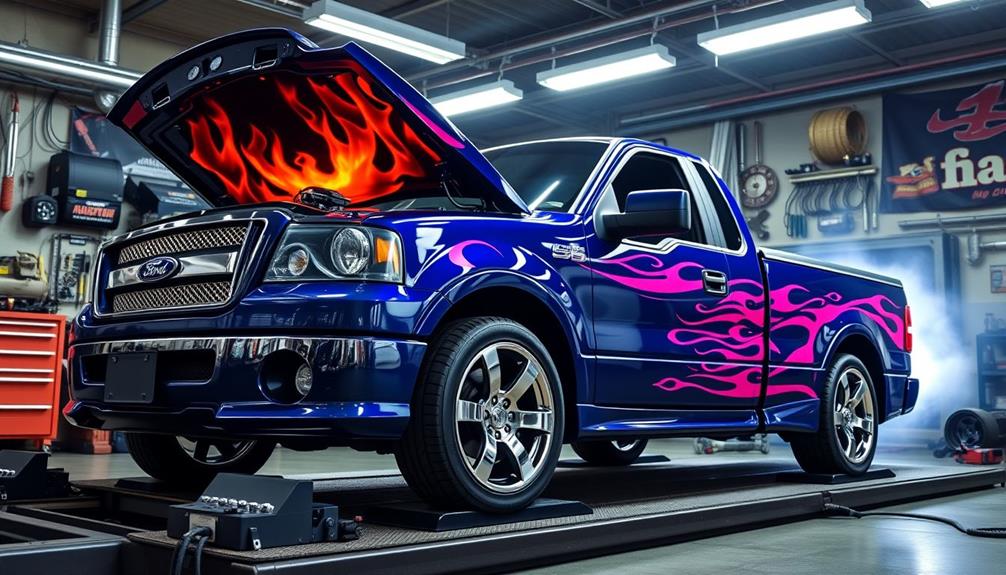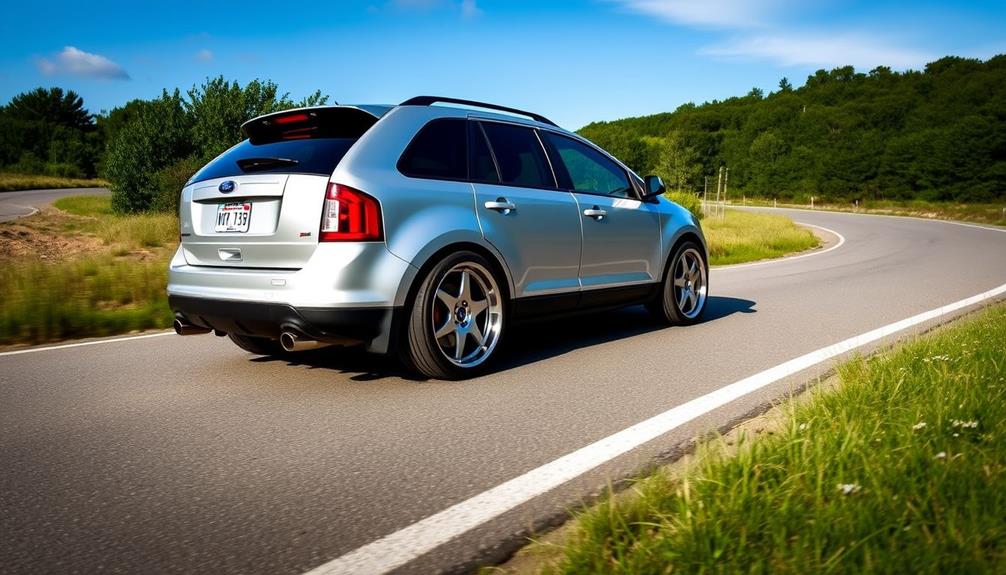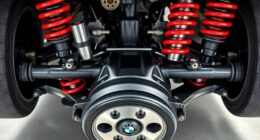Tuning your 1989 Ford Ranger can greatly enhance its performance and bring modern power to your classic pickup. With simple modifications, like high-flow intake systems and performance exhausts, you could see a horsepower boost of up to 20%. Consider an engine swap to a 4.0L for considerable power increases, or even a supercharger for serious gains. Regular maintenance guarantees your upgrades work efficiently while preventing costly repairs. Engaging with dedicated forums can provide tips and encouragement. If you're curious about more ways to transform your Ranger, you'll uncover plenty of options to make your truck stand out.
Key Takeaways
- Tuning your 1989 Ford Ranger can enhance horsepower and torque by 10-20%, improving overall performance.
- Upgrading to a 4.0L engine or installing a supercharger significantly increases power while maintaining efficiency.
- High-flow intake systems and performance exhausts are effective modifications that enhance airflow and boost horsepower.
- Regular maintenance, including sensor checks and coolant system upgrades, ensures optimal engine performance and longevity.
- Engaging with dedicated forums provides valuable insights and experiences for successful tuning and modifications.
Importance of Tuning
Tuning your 1989 Ford Ranger is vital for releasing its full potential. By optimizing your vehicle's settings, you can greatly enhance horsepower and torque, often seeing improvements of 10-20% with the right modifications. This is particularly important if you've added aftermarket parts like performance programmers or upgraded exhaust systems.
A proper tune guarantees your air/fuel mixture and ignition timing are spot-on, allowing for smoother acceleration and improved fuel efficiency. Given that older engines can be less efficient, tuning becomes even more paramount for maintaining performance and preventing engine wear.
Using modern tuning solutions, such as handheld tuners, can make this process easier. With plug-and-play installations, you can monitor essential engine parameters in real time, leading to more informed adjustments.
Regular maintenance and tuning are key; neglecting these can result in decreased horsepower and potential engine damage over time.
Performance Modifications
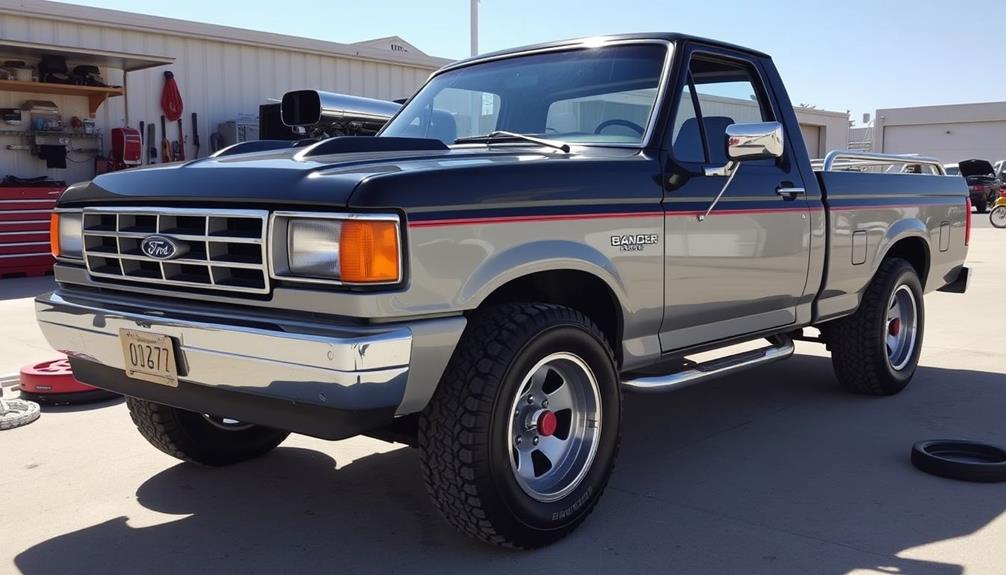
Maximizing your 1989 Ford Ranger's performance involves a range of exciting modifications that can transform your driving experience.
By making some strategic upgrades, you can markedly enhance horsepower and torque while enjoying a more engaging ride.
Here are some key performance modifications to contemplate:
- High-flow intake system: Improve airflow and boost horsepower with conical filters.
- Performance exhaust system: Installing headers can enhance exhaust flow and add up to 10 horsepower while improving engine sound.
- Shift kit: This upgrade will enhance your automatic transmission's responsiveness, making gear shifts feel more engaging.
- Engine swap: Think about upgrading from the stock 2.9L to a 4.0L engine for a considerable power increase, as these engines are often direct bolt-ins.
- Regular maintenance: A full tune-up and cooling system upgrades are essential to guarantee your engine runs efficiently, maximizing the benefits of your modifications.
Engine Swaps
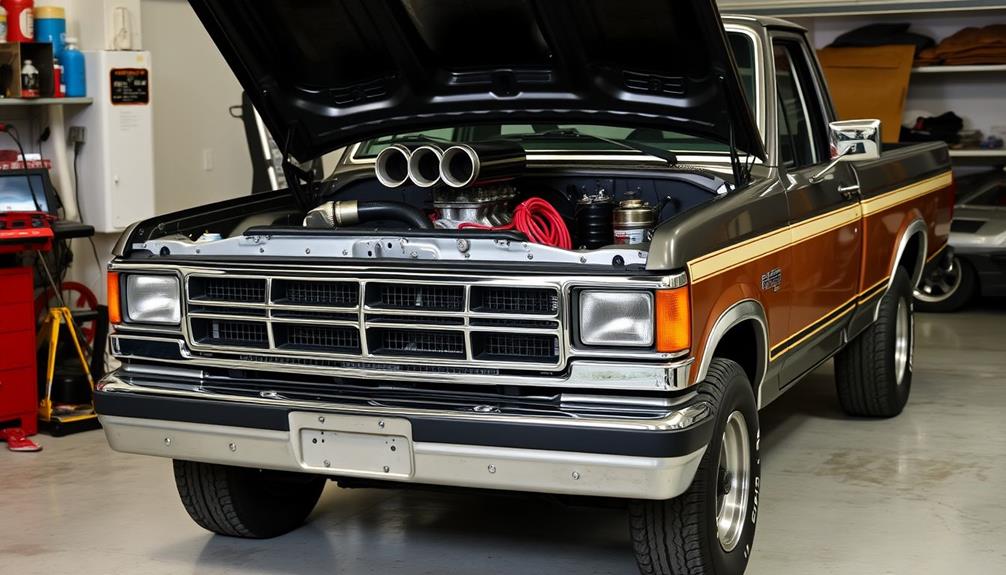
When you're looking to boost your 1989 Ford Ranger's performance, an engine swap can be a game changer.
Options like the 4.0L engine provide a significant power increase, while the 2.3L DOHC engine offers a balance of power and efficiency.
Understanding the benefits and popular choices will help you make an informed decision for your upgrade.
Benefits of Engine Swaps
Engine swaps can dramatically transform your 1989 Ford Ranger, offering numerous benefits that enhance both performance and drivability.
Whether you're upgrading to a more powerful engine or seeking improved fuel efficiency, the right swap can make a world of difference. Many enthusiasts find that investing in performance upgrades, similar to those seen in precious metal investments, can yield considerable returns in both enjoyment and vehicle capability.
Here are some key benefits of engine swaps:
- Increased Horsepower and Torque: Upgrading to a 4.0L engine notably boosts performance.
- Modern Aftermarket Options: With a V8 engine swap, like a 302 or 5.0L, you gain access to a wide range of aftermarket parts for further enhancements.
- Improved Fuel Efficiency: A dual overhead cam (DOHC) engine, such as a 2.3L, can yield up to 143 horsepower while enhancing fuel efficiency.
- Enhanced Tuning Potential: Engine swaps allow for proper tuning, ensuring peak performance and responsiveness.
- Emissions Compliance: With careful consideration of emissions compliance, you can maintain your vehicle's legality and resale value.
Keep in mind that you'll need to assess components like transmission compatibility and engine mounts during the installation process.
A successful engine swap can breathe new life into your Ranger, making it a formidable pickup for any adventure.
Popular Engine Options
Exploring popular engine options for your 1989 Ford Ranger can open up a world of performance possibilities. One of the best choices is swapping the original 2.9L engine for a more powerful 4.0L engine. This engine swap not only offers a significant horsepower increase but also provides impressive torque with a direct bolt-in installation.
If you're looking for fuel efficiency along with performance, consider installing a 2.3L DOHC engine, which delivers 143 horsepower.
For serious power enthusiasts, a V8 engine swap, such as the 302 or 5.0L, can yield up to 215 horsepower and comes with extensive aftermarket support for upgrades. Alternatively, you might want to replace the original engine with a 2.5L from a 1998 Ranger, which simplifies the installation while boosting torque.
Don't overlook the option of supercharging your 1989 Ranger. An M-90 Eaton Supercharger can elevate your power output to around 150-160 horsepower, utilizing a clutch mechanism for on-demand performance enhancement.
With these popular engine options, you can transform your classic pickup into a modern powerhouse.
Maintenance Recommendations
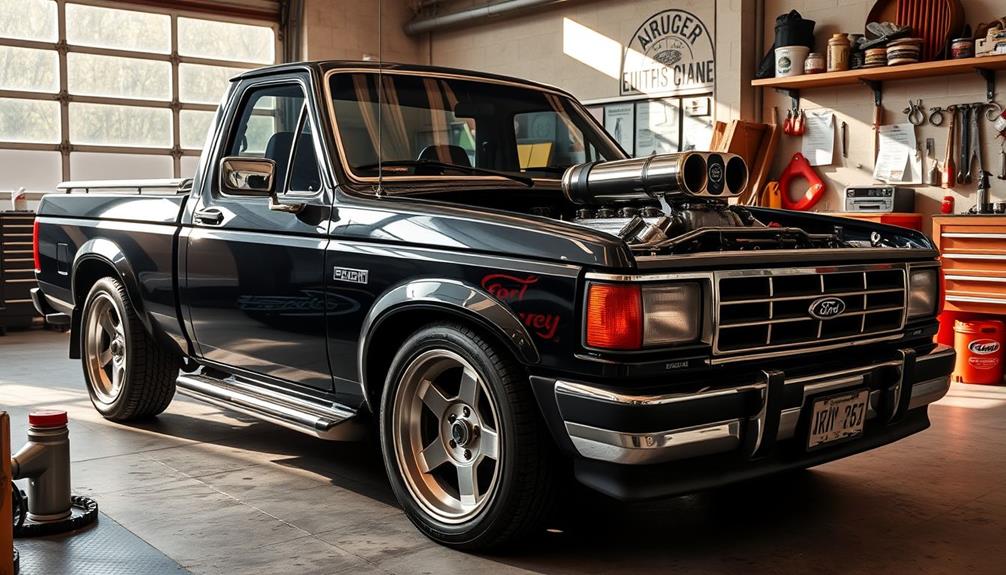
To keep your 1989 Ford Ranger running smoothly, regular tune-ups are a must.
Don't overlook the cooling system and sensor maintenance, especially if you're planning any performance upgrades.
Staying on top of these essentials will help you maximize your engine's potential and longevity.
Regular Tune-Ups
Regular tune-ups are vital for keeping your 1989 Ford Ranger running at its best. By performing these maintenance tasks, you can boost engine performance and restore lost horsepower.
Here are some key elements to focus on:
- Replace spark plugs and wires: This can greatly improve combustion efficiency.
- Change the air filter: Guarantees ideal airflow to the engine.
- Replace the fuel filter: Maintains proper fuel delivery for improved efficiency.
- Schedule regular oil changes: Prevents engine wear and keeps everything lubricated.
- Perform coolant flushes: Helps avoid overheating and maintains engine health.
Don't forget to keep an eye on the thermostat, as it plays a critical role in regulating engine temperature.
Additionally, regular checks on sensor connections can help you catch any potential issues early on, preventing costly repairs down the line.
By sticking to a routine tune-up schedule, you can guarantee that your classic Ranger not only runs smoothly but also performs effectively on the road.
Your commitment to maintenance is a smart investment in the longevity and reliability of your vehicle.
Cooling System Upgrades
Upgrading your 1989 Ford Ranger's cooling system can make a significant difference in performance and reliability.
Start by considering an aluminum radiator. It enhances cooling efficiency and provides better heat dissipation, especially when pushing your truck to its limits. Pair this with a high-flow water pump to improve coolant circulation, helping maintain ideal engine temperatures during daily use or more demanding conditions.
Don't forget about coolant additives. They can enhance thermal conductivity, which means better heat transfer and a reduced risk of engine overheating.
Regular maintenance is key, so make it a habit to flush your cooling system and replace old coolant every two years. This practice prevents corrosion and buildup that can impair performance.
Additionally, keep an eye on your hoses and clamps. Monitoring them for wear and replacing any that look damaged can prevent leaks, ensuring your cooling system maintains proper pressure.
Sensor Maintenance Checks
Maintaining your 1989 Ford Ranger's sensors is just as important as optimizing its cooling system. Proper sensor maintenance guarantees your engine performs efficiently and helps improve fuel economy.
Here are some key checks you should regularly perform:
- Inspect sensor connections for secure and clean contacts.
- Perform a voltage check and resistance check on the Throttle Position Sensor and Mass Air Flow sensor.
- Clean the MAF sensor with specialized cleaner to prevent dirt buildup.
- Monitor the engine's performance for any diagnostic trouble codes (DTCs).
- Replace sensors promptly if they show signs of wear or damage.
Cost Considerations
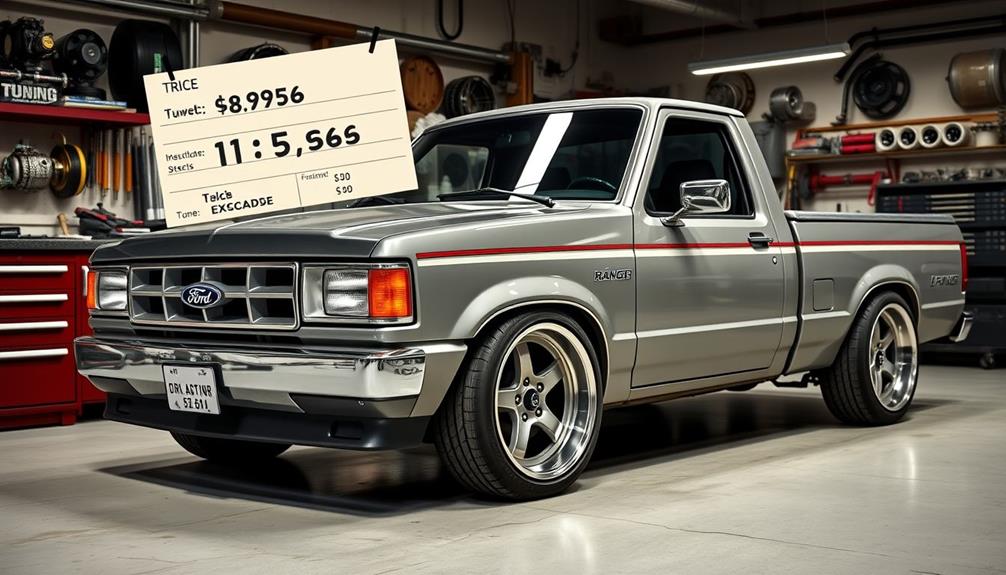
When diving into tuning your 1989 Ford Ranger, it's important to keep an eye on your budget. Most modifications won't increase your vehicle's resale value, so understanding your budget constraints is key. Significant power increases often come with hefty price tags, especially for advanced performance upgrades like forced induction. You'll want to weigh the costs against the expected horsepower gains.
Here's a quick breakdown of potential costs:
| Modification Type | Estimated Cost | Benefits |
|---|---|---|
| Basic Maintenance | $100 – $300 | Maximizes engine performance |
| Performance Upgrade | $500 – $2,000 | Significant power increases |
| Gear Ratio Change | $300 – $800 | Enhances throttle response |
| Total Cost of Ownership | Varies | Includes maintenance & modifications |
Regular maintenance can help prevent costly repairs in the future, making it an investment worth considering. When you assess the total cost of ownership, including potential modifications, you'll be better prepared to enhance your classic Ranger effectively. Balancing your budget with desired modifications is vital for long-term satisfaction.
Gear Ratio Adjustments
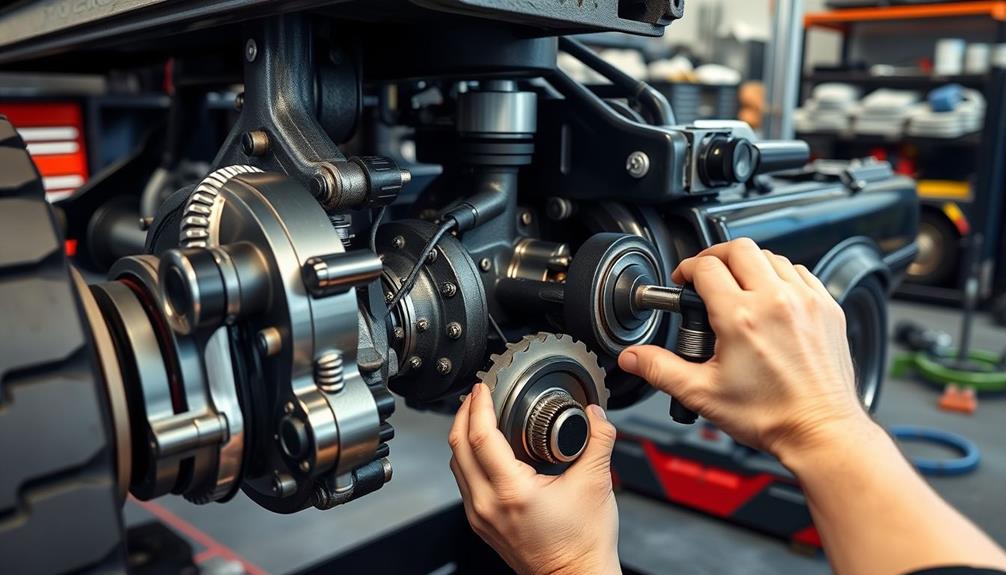
Tuning your 1989 Ford Ranger goes beyond basic modifications, and one effective way to enhance its performance is through gear ratio adjustments.
By optimizing the gear ratio, you can greatly improve acceleration and throttle response, maximizing the engine's torque multiplication. A popular upgrade is switching to 4.10 gears, which allows your engine to hit a higher RPM range for better power delivery while maintaining decent fuel efficiency.
Here are some key considerations for gear ratio adjustments:
- Acceleration Improvement: Lower gear ratios boost torque at the wheels, enhancing take-off speed.
- Throttle Response: Fine-tuning the ratio can provide more immediate engine feedback.
- Performance Upgrade: A well-matched gear ratio complements your transmission and intended use.
- Fuel Efficiency: Higher ratios may improve highway efficiency but can impact acceleration.
- Differential Type: Confirm compatibility with your new gears for a proper setup.
Community Insights

The vibrant community surrounding the 1989 Ford Ranger is a treasure trove of knowledge and experience for enthusiasts. Engaging in forums dedicated to your Ranger can provide invaluable community insights.
With over 5.3K threads and 139K messages in the Off-Road & 4×4 section, you'll find plenty of discussions on performance upgrades, including popular exhaust and intake modifications.
Members frequently share their experiences on various engine swap options, such as upgrading to a 4.0L engine, which can lead to significant power and torque increases. Tuning discussions are rich with information, allowing you to tailor your Ranger to fit your needs.
Participating in regional forums, with 1.4K threads and 22.3K messages, gives you access to local meetups and the chance to connect with fellow enthusiasts who can share tuning experiences specific to your area.
Users often post detailed accounts of their tuning journeys, highlighting how to achieve performance enhancements while maintaining emissions compliance. By tapping into this collective knowledge, you'll gain insights that can transform your 1989 Ranger into a modern powerhouse while staying true to its classic roots.
Popular Upgrades

Upgrading your 1989 Ford Ranger can greatly enhance its performance and driving experience.
With a few key modifications, you can transform your classic pickup into a powerhouse that rivals modern trucks.
Here are some popular upgrades to evaluate:
- 4.0L engine swap: Replace your stock 2.9L with a 4.0L for a significant torque increase and horsepower boost.
- Supercharger installation: A supercharger like the M-90 Eaton can ramp up your horsepower to 280 while maintaining engine efficiency.
- Performance intakes and high-flow filters: These modifications improve airflow, enhancing performance and potentially increasing horsepower.
- Performance exhaust system: Installing a performance exhaust system reduces back pressure, allowing for better exhaust flow and improving overall engine efficiency.
- Shift kits for automatic transmissions: Upgrade your automatic transmission with shift kits to enhance shift responsiveness, providing a sportier driving experience without needing more engine power.
Emissions Compliance

Steering through emissions compliance is vital when tuning your 1989 Ford Ranger, especially if you live in a state with strict regulations. Each state has specific emissions standards based on your vehicle's year, so it's important to check local laws before making modifications.
Installing aftermarket parts, such as performance tuners or exhaust systems, often requires emissions testing to verify that your upgrades adhere to these rules.
If you're considering upgrading to a more modern engine, like a 4.0L, it can enhance your Ranger's performance while potentially improving emissions output. However, keep in mind that your modified setup must still pass emissions testing based on the original model year.
Maintaining functional emissions control systems is key to staying compliant. Make sure your catalytic converters and oxygen sensors are in good working order.
Removing or failing to replace these components can lead to significant fines and legal issues, jeopardizing your pickup's legal operation.
Prioritizing emissions compliance not only helps you avoid penalties but also contributes to a cleaner environment, guaranteeing your classic truck remains a proud part of the road.
Planning Your Build
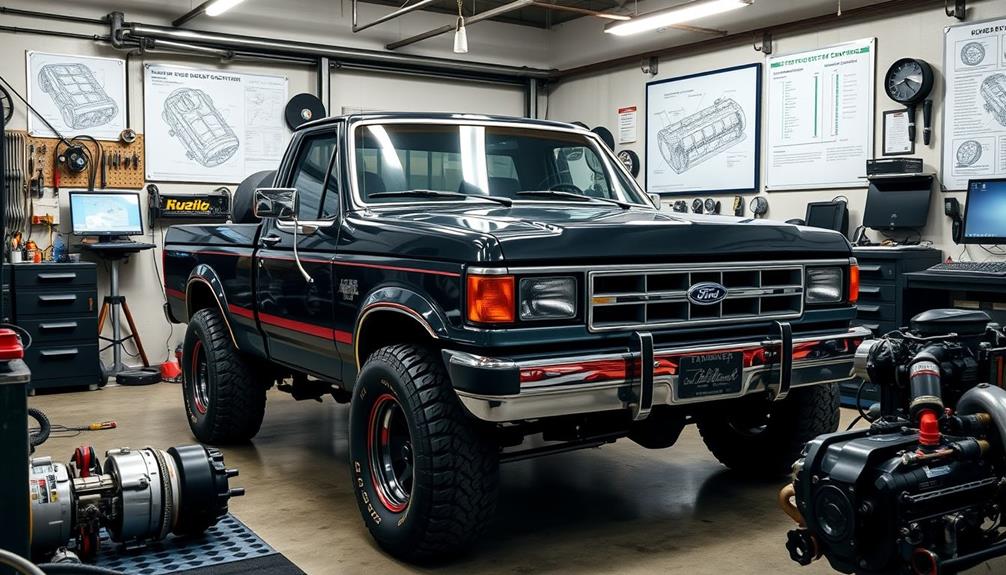
When it comes to planning your build for the 1989 Ford Ranger, defining your performance goals is vital.
Do you want increased horsepower, improved fuel efficiency, or a balance of both? This decision will steer your tuning modifications.
Here are some key steps to ponder:
- Set clear performance goals: Identify whether you're prioritizing power or efficiency.
- Establish a budget: Account for parts and labor; tuning can range from basic upgrades to extensive modifications.
- Check emissions regulations: Understand the rules for your vehicle year to guarantee compliance with any modifications.
- Complete maintenance tasks: Start with a full tune-up and fix existing issues for peak engine performance.
- Explore engine swap options: Contemplate options like a 3L DOHC engine for efficiency or a V8 swap for significant horsepower gains.
Frequently Asked Questions
How Much Horsepower Does a 1989 Ford Ranger V6 Have?
The 1989 Ford Ranger's V6 engine produces around 140 horsepower at 4,800 RPM. While this might seem modest today, it offers decent torque and can be enhanced with performance modifications to boost power considerably.
Is the 1989 Ford Ranger Reliable?
Yes, the 1989 Ford Ranger is reliable. With proper maintenance, like regular tune-ups and oil changes, you can keep its 2.9L V6 engine running strong, allowing your truck to last well beyond 200,000 miles.
What Is the Best Year for Ford Ranger Pickups?
When considering the best year for Ford Ranger pickups, many enthusiasts point to 1997 for its reliability, updated styling, and strong engine options. However, 2001's refined design and safety features also make it a popular choice.
How to Make a 2.3 L Ranger Faster?
To make your 2.3L Ranger faster, upgrade the air intake, install a performance exhaust, replace the throttle body, use a performance chip, and consider adding a supercharger for substantial horsepower gains and improved responsiveness.
Conclusion
Tuning your 1989 Ford Ranger isn't just about boosting performance; it's about breathing new life into a classic icon. Imagine the thrill of hitting the open road with a ride that blends vintage charm and modern power. By carefully planning your build and embracing popular upgrades, you're not just restoring a truck—you're crafting a personal statement on wheels. So, are you ready to transform your Ranger into a powerhouse that turns heads and ignites nostalgia?



